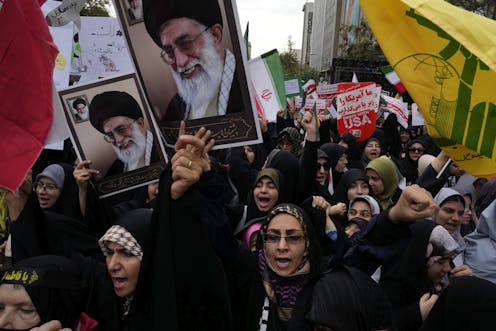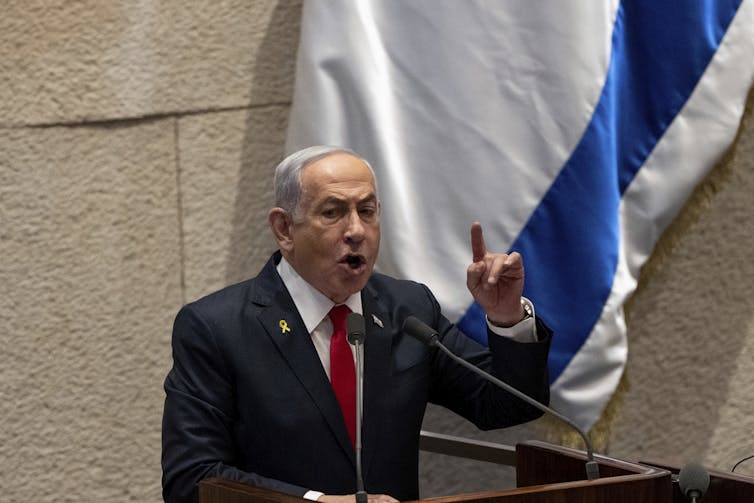Amid lull in tit-for-tat missile exchange, Iran and Israel seek to control the online narrative
- Written by Shirvin Zeinalzadeh, Graduate Teaching Associate, Arizona State University
 Holding posters of the Iranian Supreme Leader Ayatollah Ali Khamenei, demonstrators chant slogans in an annual rally in front of the former U.S. Embassy in Tehran on Nov. 3, 2024.AP Photo/Vahid Salemi
Holding posters of the Iranian Supreme Leader Ayatollah Ali Khamenei, demonstrators chant slogans in an annual rally in front of the former U.S. Embassy in Tehran on Nov. 3, 2024.AP Photo/Vahid SalemiIs Iran poised for a succession in leadership? Well, that depends on what you read.
For weeks, rumors have been swirling about the health of the supreme leader of the Islamic Republic of Iran, Ayatollah Ali Khamenei, as well as a possible replacement. In late October 2024, the Jerusalem Post picked up a New York Times report that initially suggested the octogenarian leader, who has served in the role since 1989, was seriously ill. While the Times report was updated with a correction saying it had erroneously reported on what was known about his current health, it did say that a “quiet battle” had emerged over his succession, including that his second son, Mojtaba, could succeed him.
The rumor mill again kicked into overdrive in late November, with various media outlets, including those in Israel, suggesting that Khamenei had fallen into a coma and that the race was on to appoint his successor should he remain incapacitated or worse. Iranian sourcesquickly refuted the speculation.
Such conjecture is nothing new, with reports as far back as 2007 and more recently in 2022 pointing to the supreme leader’s purportedly ill health.
The truth of Khamenei’s health aside, the speculation points to an ever-present reality: The conflict between Iran on one side and Israel and the West on the other is not just about military might and threats – there is also an information battle being waged.
In that battle, the narrative of Khamenei’s poor health can be seen as a proxy for the health and stability of the Islamic Republic. One story has it that the Islamic Republic is unstable and just one major event away from wholesale change; the other, that the government in Tehran is well positioned to deal with both internal succession and external ideological foes.
The war of words
The speculation regarding Khamenei’s health comes amid a particularly tense moment in Israeli-Iranian relations. For the past year, the long-time foes have exchanged fiery rhetoric, which has been exacerbated by a series of escalatory events, including high-profile assassinations of Iran-alligned figures in Gaza, Lebanon and Tehran, and more lately direct military confrontation.
Throughout, both sides have utilized media and online platforms to push opposing official narratives that then find digital echo chambers.
Take the tit-for-tat missile strikes in October. Israel and Iran sought to downplay the impact of the respective strikes on their own territory by feeding media with statements suggesting littledamage had been done.
At the same time, media sources from inside both nations were quick to suggest that the strikes had fulfilled their goals. Iranian media suggested Iranian missiles hit about 90% of Israeli targets; Israeli media countered that major Iranian nuclear research facilities had been hit and severely impaired Iran’s research capabilities.
Such narratives are designed not only to send self-proclaimed messages of victory to the other side but also to appease domestic audiences. For Tehran, the messaging is intended to extend further, namely to regional partners – suggesting that Israel had been weakened by Iran’s attack and that Tehran still has their back.
Social media has played a key role in getting these counter messages across to a wider public. Since 2010, Iran has sought to distort the social media landscape through the establishment of pro-regime “sock puppets” that amplify pro-government propaganda. Former Iranian Intelligence Minister Heider Moslehi acknowledged back in 2011 that Tehran had made a large investment in “heavy information warfare.”
 Israel’s Prime Minister Benjamin Netanyahu addresses lawmakers in the Knesset, Israel’s parliament, in Jerusalem on Nov. 18, 2024.AP Photo/Ohad Zwigenberg
Israel’s Prime Minister Benjamin Netanyahu addresses lawmakers in the Knesset, Israel’s parliament, in Jerusalem on Nov. 18, 2024.AP Photo/Ohad ZwigenbergMeanwhile, Israel and other opponents of the Iranian government utilize online platforms to carry messages directly to the people of Iran, too. Both Israeli Prime Minister Benjamin Netanyahu and Reza Pahlavi, the exiled son of the former Shah of Iran, have used YouTube and other platforms to encourage rebellion against the government in Tehran.
Iran has used similar digital channels, with veteran diplomat Mohammad Javad Zarif using the platform to highlight Iran’s culture and history and shared values with Jews, while at the same time slamming the Israeli government for its role in pushing the Trump administration to abandon the Iran nuclear deal in 2018.
What does it all mean?
The exchange of missile strikes by Iran and Israel in October prompted widespread speculation among media outlets, politicians and diplomats that the region was on the brink of a full-scale conventional war.
Indeed, the rhetorical exchanges between Tehran and Tel Aviv include explicit threats of devastating retaliatory measures and warnings of significant escalation. Yet the cycle of reciprocal strikes has, to date, appeared to satisfy the strategic objectives of both sides’ military leadership.
And for now, the information and messaging war is again seemingly taking precedence over actual hot war.
After the last missile strike, carried out by Israel on Oct. 26, Iran stated that it retained the right to respond at a time and method of its choosing. But that, too, was perhaps an extension of the media narrative campaign.
Rather, the current situation suggests to me a deliberate and calculated strategy by both Iranian and Israeli forces to conserve their respective military resources, while attempting to achieve domestic and regional objectives via the information war.
For Israel, this means pushing the narrative that it has displayed the capability to reach critical Iranian infrastructure and sensitive security targets as desired. For Iran, it takes the form of saying it has reestablished sufficient deterrence against a stronger Israeli military.
Having escalated into direct military confrontation, the Iran-Israel conflict appears to have entered a new transitional phase.
Iranian state media continue to condemn Israeli actions in Gaza and Lebanon, while simultaneously issuing statements from senior military commanders reaffirming Tehran’s readiness to respond to perceived acts of aggression.
But for now, at least, warfare is being conducted via information and disinformation rather than through conventional military weapons.
Shirvin Zeinalzadeh does not work for, consult, own shares in or receive funding from any company or organization that would benefit from this article, and has disclosed no relevant affiliations beyond their academic appointment.
Authors: Shirvin Zeinalzadeh, Graduate Teaching Associate, Arizona State University

